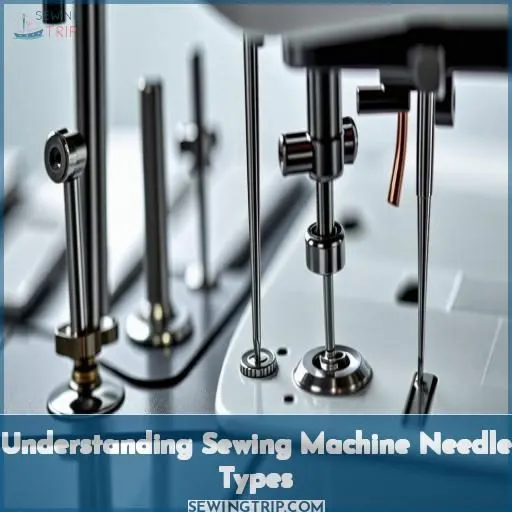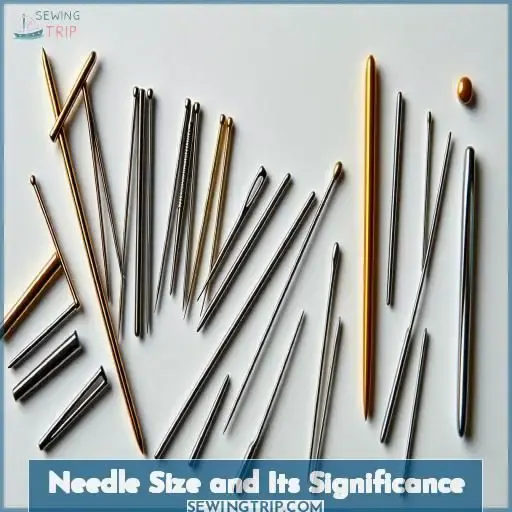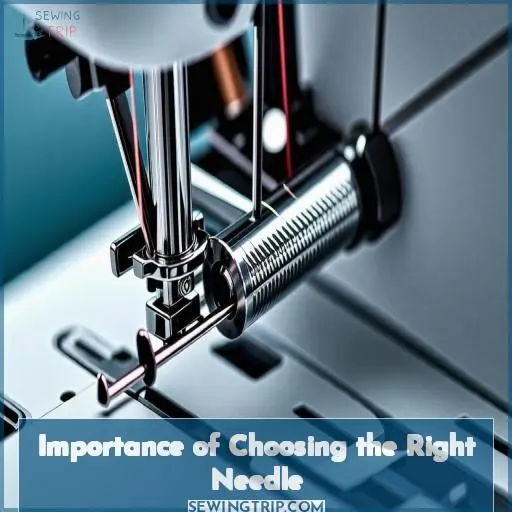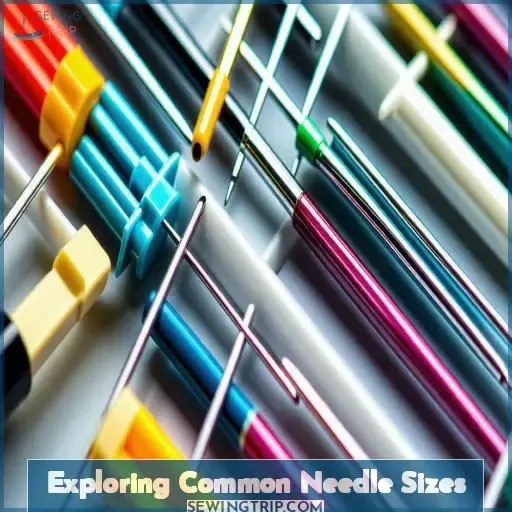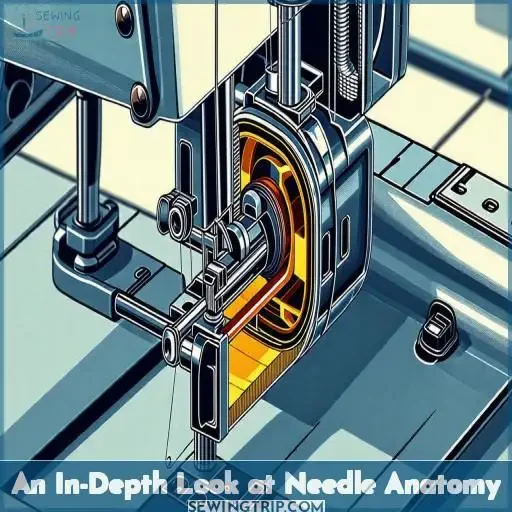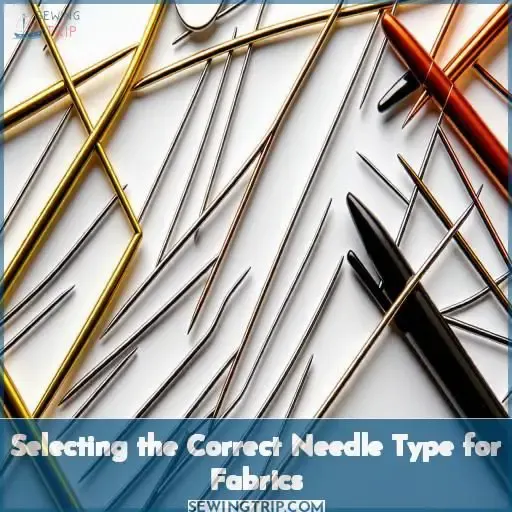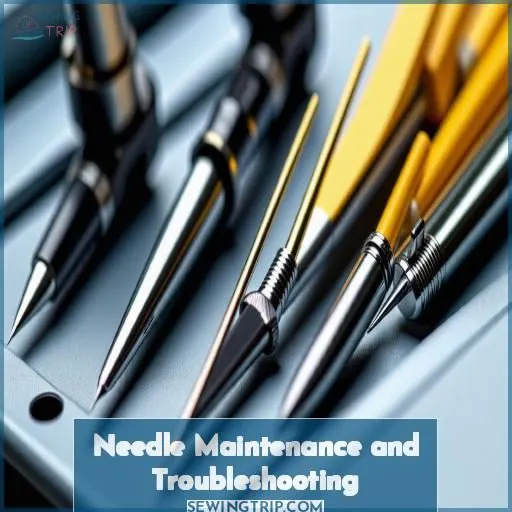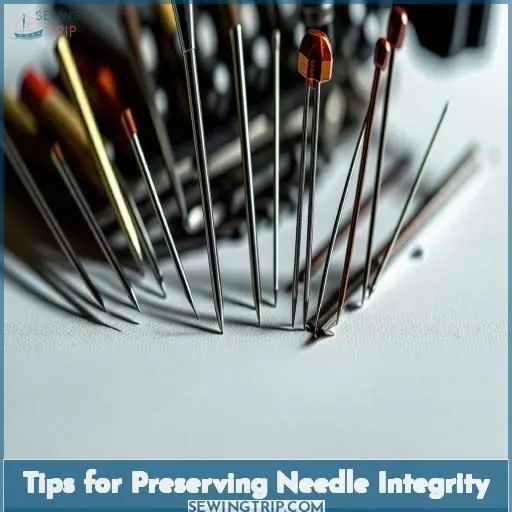This site is supported by our readers. We may earn a commission, at no cost to you, if you purchase through links.
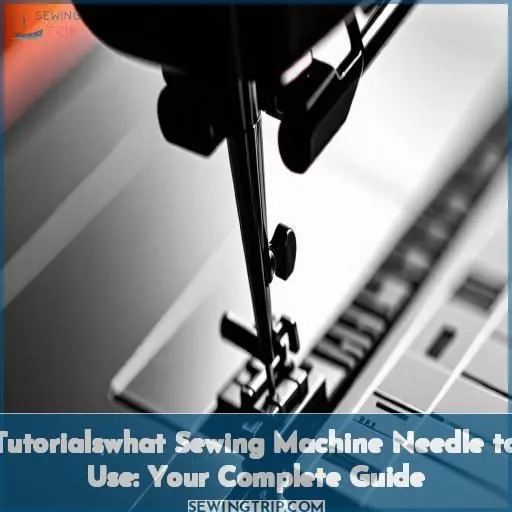 You’re wise to seek guidance on what sewing machine needle to use, as the proper needle is crucial.
You’re wise to seek guidance on what sewing machine needle to use, as the proper needle is crucial.
The needle type and size should match your fabric’s weight and composition.
For example, use a smaller needle (like 60/8) for delicate fabrics, and a thicker one (90/14+) for sturdy materials.
Specialty needles, such as stretch or quilting needles, are designed for specific fabric properties.
Replace needles frequently to prevent skipped stitches, damage, and strain on your machine.
With the right needle, your projects will have a professional finish – continue on to learn the finer nuances of needle selection.
Table Of Contents
- Key Takeaways
- Understanding Sewing Machine Needle Types
- Needle Size and Its Significance
- Importance of Choosing the Right Needle
- Exploring Common Needle Sizes
- An In-Depth Look at Needle Anatomy
- Selecting the Correct Needle Type for Fabrics
- Needle Maintenance and Troubleshooting
- Tips for Preserving Needle Integrity
- Frequently Asked Questions (FAQs)
- Conclusion
Key Takeaways
- Choosing the correct sewing machine needle is crucial for achieving high-quality results and preventing damage to the fabric and machine.
- Needle type and size should be selected based on the weight and composition of the fabric being sewn, with specialty needles available for specific materials like knits and leather.
- Proper needle maintenance, including regular replacement, inspection, and lubrication, is essential for ensuring smooth stitching performance.
- Understanding the anatomy of a sewing machine needle and the various size options available empowers sewers to make informed decisions for their projects.
Understanding Sewing Machine Needle Types
When it comes to sewing machine needles, comprehending the different types is essential for achieving impeccable results.
Universal needles are the preferred choice for most fabrics.
While ballpoint or jersey needles are designed for knits to prevent snags and laddering.
Stretch needles, on the other hand, are meticulously engineered for elastic materials, ensuring your stitches remain robust and secure.
For quilting and dense fabrics, sharp needles are the way to go.
While quilting needles offer a shorter length for swift stitching through multiple layers.
Proper needle orientation and storage are also critical.
Always insert the needle with the flat side facing the back, and keep your needles in a dry place to maintain their integrity.
Needle Size and Its Significance
Sewing machine needles come in a range of sizes, and selecting the correct one is paramount for your project’s success.
The size of a needle is determined by the diameter of its shaft, which is measured in both metric and imperial systems.
Typically, needle sizes range from 60 to 110 in the metric system and 8 to 18 in the imperial system.
A smaller number indicates a finer needle, appropriate for lightweight fabrics like silk and chiffon, while larger numbers are used for heavier fabrics such as denim and canvas.
To guarantee satisfactory performance, always refer to the needle size chart provided by your sewing machine manufacturer or the fabric weight guidelines on the needle package.
Importance of Choosing the Right Needle
Selecting the correct sewing machine needle is essential for achieving high-quality results. The needle type must be compatible with the fabric to prevent skipped stitches, damage to the material, and strain on your sewing machine.
Fabric Compatibility Ensures Quality
Choosing the correct sewing machine needle is essential for fabric compatibility and stitch quality. Universal needles are suitable for most fabrics, while specialty needles like ball point, embroidery, jeans, and leather are designed for specific materials. Matching the needle to your fabric prevents damage and ensures smooth, consistent stitching.
Needle Condition Impacts Stitch Performance
Inspecting your sewing machine needle regularly is essential, as a dull or damaged needle can greatly affect stitch quality. Replace needles after each project or if you notice any unusual thumping during sewing. Proper needle care guarantees maximum stitch performance and prevents fabric damage.
Proper Needle Selection Prevents Damage
Selecting the right needle prevents damage to your sewing machine. Poor needle choice can lead to broken or bent needles, skipped stitches, and damage to the fabric or machine. To avoid these issues, consider fabric type, weight, and the appropriate needle size and type for the specific project (Source).
Exploring Common Needle Sizes
Regarding sewing machine needles, size is important!
Needle sizes range from 60 to 110 in the metric system and 8 to 18 in the American system. The higher the number, the thicker the needle.
For most dressmaking projects, an 80/12 needle is a versatile choice. However, you may need to adjust based on your fabric.
Delicate fabrics like silk and chiffon require a finer 60/8 or 70/10 needle, while sturdy fabrics like denim and canvas need a stronger 90/14 or 100/16 needle.
Specialty needles like stretch, twin, triple, and topstitch also come in various sizes to fit your project requirements.
Always refer to your needle package or machine manual for recommended sizes. Appropriate needle selection ensures smooth stitching and prevents fabric damage or needle breakage.
An In-Depth Look at Needle Anatomy
Sewing machine needles are precision instruments, each with a unique anatomy designed to handle specific fabrics and tasks. Let’s explore the key components:
- The shank is the flat-backed portion that inserts into the machine, ensuring proper orientation.
- The shaft refers to the needle’s thickness, which varies based on the intended fabric weight.
- The eye is the hole through which the thread passes, with size and shape suited for different thread types, from delicate embroidery to heavy-duty topstitching.
Understanding these intricate details empowers you to select the right needle for your project, preventing skipped stitches, fabric damage, and frustrating machine jams. Whether you’re sewing denim, metallic threads, or delicate quilting layers, the needle’s anatomy is the key to a smooth, successful sewing experience.
Selecting the Correct Needle Type for Fabrics
To achieve the best stitching results, you’ll need to select the appropriate needle type based on the fabric you’re working with. Different fabrics require specific needle types – choosing the correct one will guarantee your stitches are neat, sturdy, and won’t cause damage to the material.
Needle Types for Fabric
Selecting the appropriate needle type is essential for fabric compatibility. Specialized needles such as sharps, ball points, and stretch needles are designed to handle natural fibers, knits, and elastic fabrics respectively. Pay careful attention to the needle eye shape and point variation to prevent fabric damage. (Source)
Needle Size for Fabric Weight
When selecting the right needle for your fabric, consider the weight and thickness. Heavier fabrics like denim require larger needle gauges, while lightweight fabrics need finer needles. Needle length also matters – longer needles work better for multiple fabric layers. Proper storage helps maintain needle durability.
Proper Needle Maintenance
Proper needle maintenance is key for best sewing performance. Store needles securely, inspect for damage before use, and dispose of dull or bent needles. Lubricate the needle shaft periodically to prevent friction and heat buildup. Sharpen needles with a honing stone for extended lifespan. Follow these tips for a smooth sewing experience.
- Needle storage
- Needle lubrication
- Needle inspection
- Needle disposal
- Needle sharpening
Needle Maintenance and Troubleshooting
Regarding needle maintenance for your sewing machine, several key aspects require your attention.
Regularly changing needles after 6 hours of sewing or at the project’s conclusion is a critical practice to maintain stitch quality and prevent needle damage .
Before each use, carefully inspect the needle for any signs of damage, such as bending, burrs, or dullness .
Proper needle lubrication is essential to guarantee smooth operation and prevent breakage.
Store needles in a dry place to prevent corrosion and maintain their integrity .
Additionally, if you encounter needle breakage, consider adjusting the machine tension and examining your needle usage—it could be the wrong needle for the fabric or overloading the machine with fabric .
These troubleshooting techniques will help you identify and resolve needle-related issues effectively.
Tips for Preserving Needle Integrity
To preserve your sewing machine needle’s integrity, follow these simple tips:
- Store needles properly in a dry, dust-free environment to prevent corrosion and damage.
- Always use the correct needle for the fabric and thread type to avoid premature wear.
- Regularly lubricate your machine according to the manufacturer’s instructions to reduce friction and heat buildup, which can dull needles faster.
Maintain needle sharpness by replacing them after every project or if you notice any bending, blunting, or burrs. Damaged needles can cause skipped stitches, thread breakage, and even fabric damage. Invest in a high-quality needle case to keep your collection organized and protected. With proper care and storage, your sewing machine needles will serve you well for many projects to come.
Frequently Asked Questions (FAQs)
How do I know what sewing machine needle to use?
You should choose a needle based on the fabric’s weight and type. Use sharp needles for natural fibers, ballpoint for synthetics, stretch for knits, and leather needles for leather. The needle size should match the fabric—smaller for lighter fabrics, larger for heavier.
What is a 90-14 needle used for?
A 90/14 needle is a versatile all-purpose needle suitable for medium-weight fabrics like cotton, linen, and polyester blends. It’s a common choice for dressmaking and general sewing projects.
Does it matter what needle you use for sewing machine?
Yes, using the right sewing machine needle matters a lot. Different needle types are designed for specific fabrics to prevent skipped stitches, fabric damage, and needle breakage.
What is a 60/8 needle used for?
The 60/8 needle is ideal for lightweight fabrics like silk and sheer synthetics. Its fine shaft and sharp point help avoid damaging delicate fibers.
How do I properly insert a new sewing machine needle?
Carefully place the needle’s flat side into the machine’s needle clamp. Push it up until it can’t go further, then securely tighten the needle clamp screw. Verify the needle is oriented correctly for your fabric by referring to the manual.
What are the signs that a needle needs to be replaced?
You’ll know it’s time to replace your sewing machine needle when the stitches look irregular, you hear thumping noises, or the needle is bent or dull. Change needles regularly for best stitching.
Can I use the same needle for multiple projects?
Precisely piercing projects perfectly prompts proper needle preparation. Nope, needles need new nailers after each endeavor to guarantee excellent execution – extend endurance, elude errors.
How do I determine the right needle size for my fabric?
To determine the right needle size, consider the fabric weight and type. For lightweight fabrics, use smaller sizes like 60/ For heavy fabrics like denim, use larger needles around 100/ Match needle size and type to your project for best results.
What are the common causes of needle breakage during sewing?
The most common causes of needle breakage are using the wrong needle type or size for your fabric, a dull or damaged needle, sewing excessive layers, insufficient machine lubrication, and overly tight tension settings. Inspect your needle regularly and replace as needed.
Conclusion
By understanding the tutorialswhat sewing machine needle to use, you’ll improve your craftsmanship. The right needle complements fabric weight and type, ensuring professional finishes. Regularly check and replace needles for superior stitch quality. With this thorough guide, you’re now equipped to confidently navigate needle selection for flawless results on every project.

